For every new project that your team undertakes, it is crucial for things to be managed skillfully. Whether your team tackles one project at a time or runs several projects simultaneously, the core principles of project management remain the same.
Project management is both a science and an art. Understanding the basics is paramount to success. This guide shines a light on the basics of project management, including how you can effectively manage projects and what tools you need in order to take control of your career as a project manager.
What is project management?
Project management involves employing skills, methods, experience, and knowledge to achieve a goal within a specific time frame. It may involve a one-time project or a series of projects. Usually, project management also involves the management of resources, personnel, budget, and technology.
Project management is widely adopted in all industries. It has been an especially essential part of engineering and construction. Recently, companies in the healthcare and information technology industries owe a great deal of their success to effective project management.
Regardless of industry and niche, the primary objective of project management remains the same: to achieve your goals in a more structured and efficient way.
Who is a project manager?
A project manager (PM) is responsible for managing all aspects of the project and monitoring the progress and completion. Therefore, project managers must be capable of overseeing the six aspects of a project, including
- Scope
- Finance
- Risk assessment and management
- Quality control and assurance
- Schedule
- Resources
Usually, PMs make sure projects have definite outcomes within a set timeframe and clearly allocated budgets.
The four most popular project management methodologies
All project managers are aware that selecting the right project management model determines the outcome of a project. There are different methodologies, each with their own separate rules, principles, and processes. The type of methodology used by a project manager depends on the type of project being handled.
Below, we list the four most popular project management methodologies.
Agile project management
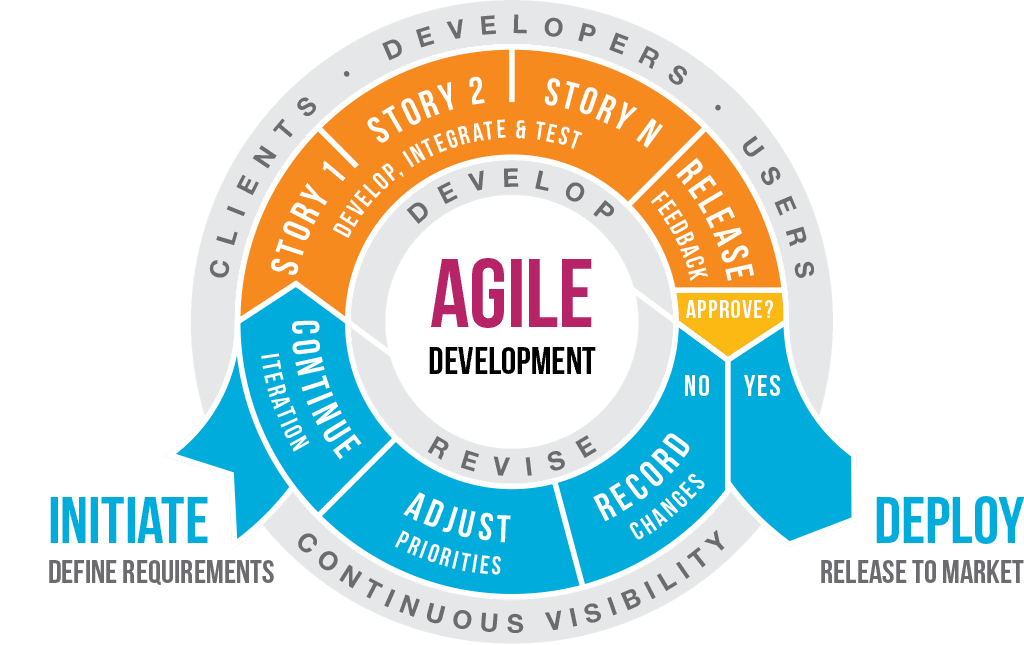
Agile project management is one of the most popular project management techniques. It is most effective for incremental and iterative projects like software development. This approach requires the team to make incremental and iterative improvements in a project throughout the project life cycle.
For instance, developing a mobile app may require the development team to release an initial version of the app and then make incremental changes in the form of features added throughout the project’s life cycle.
Agile project management is based on these four fundamental values:
- Customer collaboration: developing the product based on customer feedback rather than sticking to the contract
- Team: individuals and interactions over processes and tools
- Flexibility: responding to change rather than sticking to a plan
- Priority: working software over comprehensive project documentation
Kanban project management
The Kanban project management method is used to manage project processes by focusing on early project deliverables through collaborative and self-managing project teams.
This method focuses on producing quality deliverables by breaking the workflow into buckets of tasks. At any point in time, each task bucket must contain a set number of tasks. When a Kanban bucket is full of tasks yet to be completed, then any completed tasks from preceding buckets must be kept on hold until a space is freed up in the next bucket.
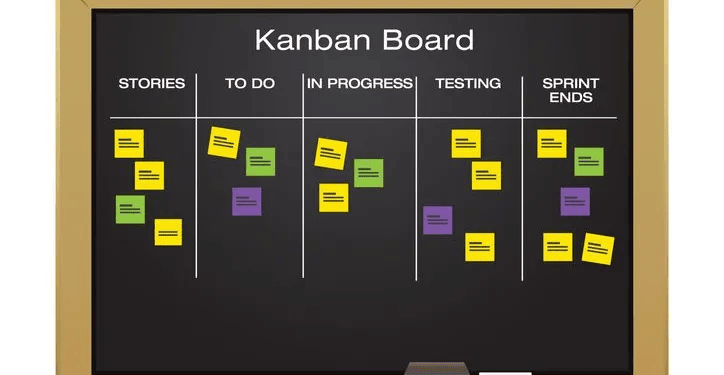
The Kanban method is particularly helpful in keeping the team organized and on project, especially when a team is managing multiple projects simultaneously.
To use the Kanban method, you should familiarize yourself with some of the following elements of its methodology.
Kanban cards: Kanban cards denote project tasks or items in the work process. Each card describes one task. It details the information required to help the project team complete that task, including the task’s status, duration, deadline, and description. Complex tasks are usually broken down into subtasks (or checklists). Each subtask should also have its own Kanban card.
Kanban boards: A Kanban board is used to visualize the entire project process and can be physical or digital. An example of a physical Kanban board is a chart or table drawn on a whiteboard, holding post-it notes. A Kanban board separates different stages of the project and allows you to fit tasks into each phase. However, each phase can only hold a maximum number of tasks at any time, which can enhance focus and help your team remain organized.
Kanban swimlanes: Swimlanes are the lines dividing the project phases, more like column separators. They help you differentiate where each task falls.
Scrum project management
Scrum project management methodology is most suitable for complex projects. In Scrum methodology, the project team focuses on a set of tasks that would help improve or create a specific part of a project. These tasks usually have a strict time frame in order to meet deadlines.
For example, a project manager at Apple focusing on developing the Live Text feature can have the team focus on completing one part of it in a single week. This strict focus on a task is called a Sprint.

Scrum methodology applies a series of Sprints to work on complex projects. A project manager using the Scrum method has to ensure that each stakeholder is taking up enough tasks and still handling them effectively. Usually, the Scrum method framework suggests following the steps below:
Sprint Meeting: The team meets to ensure that everyone understands the goal of the project. In this meeting, available data is analyzed, the scope of the project is discussed, duties are delegated, and expectations are set.
Backlogs: Both project backlogs and Scrum backlogs are created. These ordered lists contain everything that should be included in the product, the deliverables, the problems to be fixed, and the resources/ideas available to help bring the project to completion.
Sprint planning: Since the project will require more than one sprint, teams must create plans for each sprint. These include the proposed deliverables of each sprint as well as how those deliverables will be achieved. This planning is often done during the sprint meeting.
Scrums: Depending on the duration of each sprint, some projects could use daily or weekly scrums. A scrum is the actual work process where everyone focuses on their duties and delivers achieved results at the end of the scrum’s duration (ideally at the day’s end).
Sprint review: At the end of the scrum, the project team reviews the results of each sprint and assesses them against the expectations/goals set in the sprint meeting phase.
Sprint retrospective: After reviewing the result of completed sprints, the team meets to reflect and discuss opportunities for improving the next sprint. Most times, a sprint retrospective meeting transitions into the next sprint planning meeting.
Waterfall project management

The Waterfall project management method is straightforward and linear. It involves a clear definition of all the stages of a project, from start to finish. Each stage is organized to begin after the preceding stage ends, and no two stages are allowed to run simultaneously.
For example, a marketing team aiming to penetrate a new market begins by analyzing existing project data, then moves on to segmenting the audience. Thereafter, the team creates content for these target audiences, and so on until the marketing campaign is launched.
The five stages of project management
There’s a project manager behind every successful project. This PM understands the project life cycle and facilitates the project’s progress. As much as everyone believes that a project manager’s job is all about meeting deadlines, there’s much more to the role than that. In fact, a project manager’s understanding and seamless execution of the five stages of project management is one of the strongest weapons in their arsenal.
These five stages are discussed below.
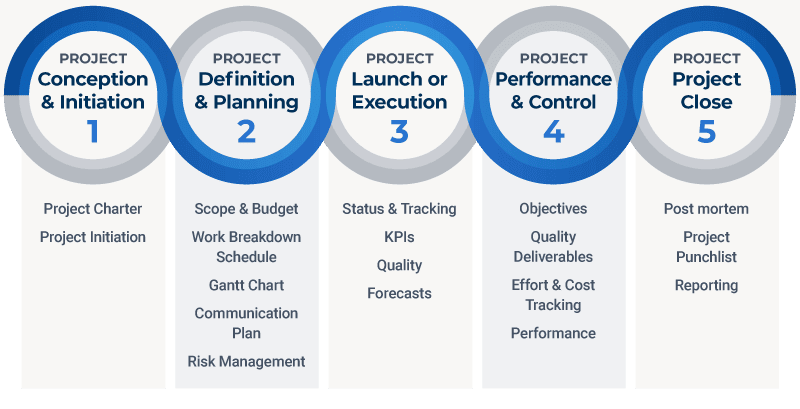
1. Initiate the project.
The objective of this stage is to define the project on a broad level. Usually, this initiation phase starts with a business case, where the team researches the business value of the project. If needed, a feasibility test can be carried out as well.
If the project is feasible, it undergoes a stakeholder review and approval process. Upon approval, a project initiation document or project charter will be created. For this document, project managers can use a project charter template as a guide. This project initiation document will contain the purpose and requirements of the project, as well as the needs of the business and its stakeholders.
2. Plan the project.
This phase determines whether the project will ultimately succeed or fail. At the planning stage, the project scope is defined. Additionally, a project management plan is developed at this stage, ideally using a project plan template.
It’s important to set goals at this early stage. There are two famous methods of setting achievable goals, which we detail below.
The SMART goal setting framework ensures that every project goal is specific, measurable, attainable, realistic, and time-bound.
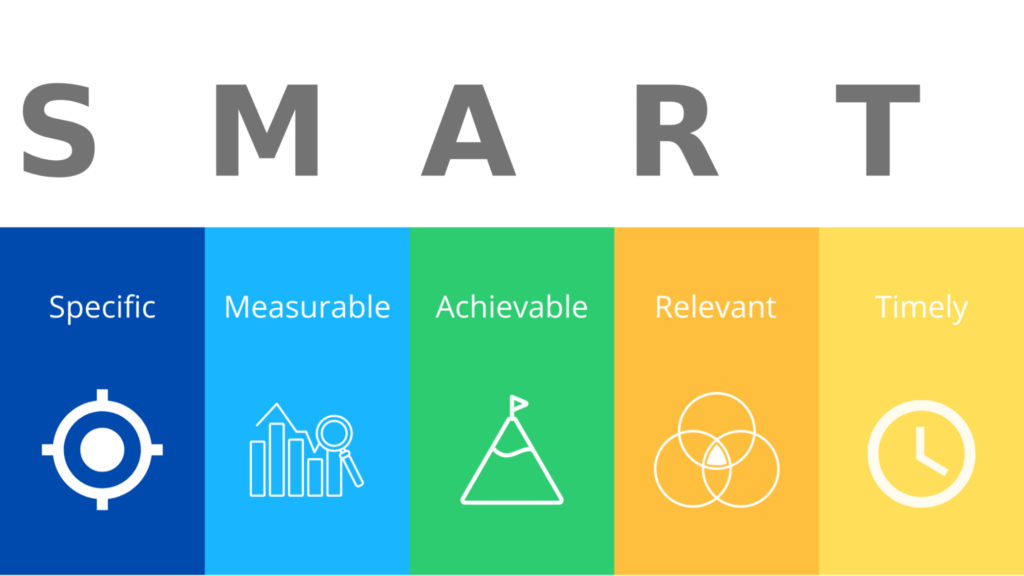
The CLEAR goal-setting framework, on the other hand, helps project managers set goals that are Collaborative, Limited, Emotional, Appreciable, and Refinable.
In the project planning stage, you also need to
- Define the budget
- Assess availability and quality of resources
- Set up a realistic timeline
- Create a work breakdown schedule
- Develop a risk management plan
- Open a communication channel
One way of creating a clear project timeline and work breakdown schedule is to utilize Gantt charts.
Baseline or performance measures are also established here. You can use project planning software to develop a baseline and workflow structure to keep the project on track and measure progress.
3. Execute the project.
This phase is where deliverables are created and published. Here, status reports and meetings, performance reports, and development updates are generated and reviewed.
Usually, this execution phase begins with a kick-off meeting where all involved team members are informed of their responsibilities. Usually, a project manager has to follow this typical process to effectively execute a project.
- Create a team
- Assign tasks and resources
- Monitor team members’ performance of tasks
- Review and approve content
- Launch and execute the project
- Establish quality standards and systems
- Measure and monitor Key Performance Indicators (KPIs)
- Hold status meetings
- Assessment quality against established standards
- Update project schedule and modify project plan, as required
4. Measure performance and control.
This phase of project management is about monitoring the progress and performance of a project and determining if it is going according to the project plan. Here, the project manager measures KPIs to assess whether the project is on track.
Typically, a project manager selects a series of KPIs to measure project performance and the completion of specific project objectives. Based on the result of this assessment, the project manager may need to make changes to the deliverables, schedule, budget, and/or resources to ensure the project’s completion. KPIs for a project could include:
- Customer satisfaction: Through surveys, a team can collect feedback from customers on their satisfaction with the organization’s products and services.
- Productivity: Measure the output of a project compared to its input.
- Cost efficiency: Compare the value the organization has earned through the project with the costs incurred.
- Time: How long did it take to complete the project? Compare this timeline to the standard benchmark cycle time of similar projects.
- Number of new leads: Calculate the number of new leads you have won through your campaign.
- Number of new customers: Analyze the number of new customers you have won through your campaign.
5. Close the project.
This phase marks the end of the project. For one-off projects, contractors hired to do a specific job are relieved of their duties here.
Good PMs prepare a final report of the entire project. Then, an evaluation of successes and failures at every stage of the project is carried out, often recognizing outstanding team members.
Post-mortem meetings are also held to assess areas of failure, likely causes, and what can be improved in future projects. These meetings may also review the success of the project, what went well and how they can be replicated.
Finally, the project manager prepares the final project report and collects all documents and deliverables for storage.
Four best practices for successful project management
Several project management principles determine the chances of a project’s success. These four best practices can help project managers make the best out of their project management and champion more successful projects.
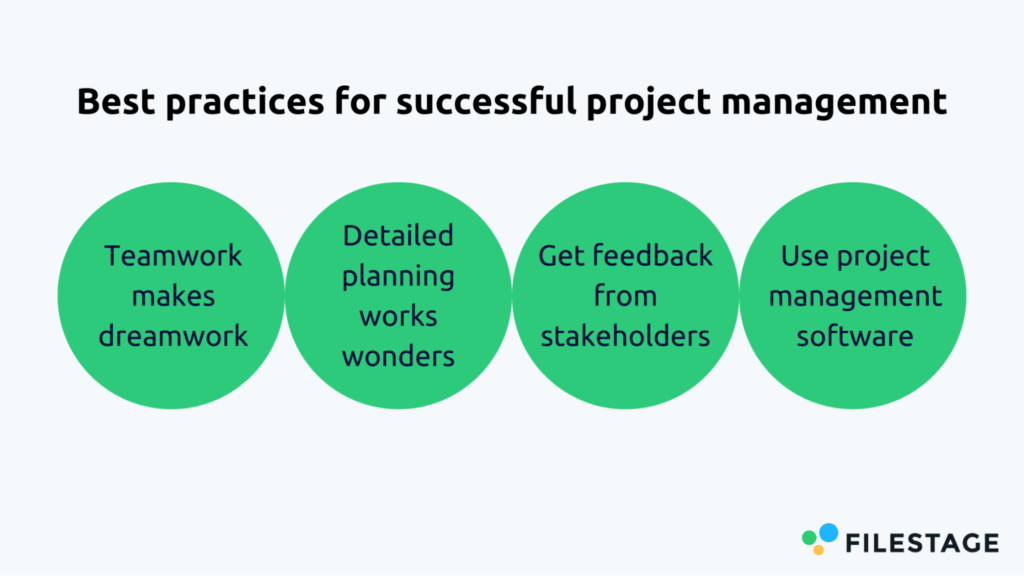
Teamwork makes dreamwork
Every successful project manager understands the relevance of a strong, collaborative team. As a PM, it is crucial to find the right set of talented individuals for your team.
In big companies, team selections can begin from within. Selecting the right members to join a project is just one step towards completing the project. Ensuring that the team is collaborative is the most important step to consider. You can build a highly collaborative project team with these five steps:
- Articulate a common purpose and goal for the team and make sure it is clearly and effectively communicated among team members.
- Trust each other and ensure that you are trustworthy as well. Trust requires that team members be allowed to express their commitments to the team’s goal and purpose as well as their reservations without being judged harshly.
- Clearly define each team member’s roles and responsibilities to avoid overlapping ownership and/or neglect of certain tasks in the hopes that another team member will handle it.
- Create a transparent work environment by using tools that allow all project members to monitor ongoing tasks.
- Set a culture for open and clear communication – the success of your team and project depend significantly on it!
Detailed planning works wonders
Successful projects require intensive planning. Outstanding project managers hold brainstorming sessions to plan projects through to the end as opposed to the “go with the flow” approach of mediocre managers.
Included in the planning of a project is choosing the right project management methodology to use. According to statistics, agile methodology has a 64% project success rate. However, other models of project management may be better suited for any specific project. A PM must understand the nuances of each model as well as those of the specific project to find the best fit.
Planning the timelines, milestones, workflow structure, and deliverables are all equally important to help set clear expectations, avoid stress, and meet deadlines.
And of course, comprehensive risk analysis cannot be left out of the detailed planning stages. Carefully analyzing potential risks will help you to be better prepared.
This can include planning for potential missed deadlines due to unforeseen circumstances. Allowing for some buffer and flexibility in the project timelines can compensate for such unexpected delays. Moreover, creating a transparent workflow structure and granting ownership to team members can help reduce common bottlenecks.
Get feedback from stakeholders
Many projects require review and approval from internal and external stakeholders of the project. A good project manager needs to set up an efficient process to get regular feedback and input from these stakeholders as well as to keep them updated. This is not only important to maintain a good relationship with your stakeholders, it also increases the quality of the project.
To make the feedback collection as easy as possible, we recommend using a review and approval tool like Filestage. With Filestage, you can share any content type like images, videos, and documents with your stakeholders through a centralized online platform.
Then, reviewers can leave comments and annotations directly on the file and even discuss items with each other in real time. This clarifies feedback, increases transparency, and avoids misunderstandings.

Use project management software
As a project manager, using project management software to structure and track a project’s progress helps you stay organized and in charge. Several project management software choices also include mobile apps with push notifications that can keep you notified as important changes occur on projects, allowing you to work on the go.
With project management software, working through various project milestones will be easy. There will be no need to constantly call the team to stay up-to-date or carry around a cumbersome paper file. Tools like these save an enormous amount of time for everyone involved while increasing transparency. Completed project milestones also encourage the team to celebrate small wins along the way.
Some PMs are equipped with chat and cloud-enabled file sharing features that can eliminate the nagging need for long chains of emails and attachments. As a product manager, you owe it to your team to find ways of simplifying complex project processes, and making use of suitable project management software is one of those ways.
What are the best project management software and tools?
Project management tools are becoming irresistible to brands and companies because they allow project managers to work more effectively.
One of the commonly searched comparisons of the project management tools is Trello vs. Asana, mainly because these applications are two of the most popular options in the industry.
However, there are many options available today. Here are some of them:
Asana

Asana is a highly effective project management tool notable for enabling collaboration in project teams of various sizes. The user experience can appear a bit awkward and hard to grasp at first. However, after the learning curve, Asana offers great flexibility and a multitude of enabling features for teams of all sorts.
Key features
- Projects can be viewed in boards, lists, and timelines
- Advanced searching and reporting abilities
- High-grade TLS 1.1 protocol security
- Tags for easy searching
- Task tracking
- Inbox, task-specific comments, and mentions
- Goal setting

- It’s flexible
- Fast and lightweight design
- Easy for managing tasks dependencies with a timeline view
- Has multiple project management framework templates

- Not suitable for graphic-intensive projects
- Has a steep learning curve for new users
Trello

Trello is a popular, lightweight product management tool with a friendly user interface and intuitive user experience. Trello has a Kanban-like structure, with tasks added to boards. However, this tool can be adapted to other project management models. It is equipped with features that make it ideal for collaborative teams of all types and sizes.
Key features
- Workflow automation with the Butler tool
- Customizable Kanban boards
- Comment and mention features

- Intuitive and minimalistic interface
- Web, desktop, and mobile apps are available
- Flexible and customizable
- Lightweight and loads quickly on all devices

- Most features require add-ons
- Limited third-party app integrations
Monday

Monday.com is a versatile project management tool completely customizable to serve your team’s project management goals. Its workflow structure is aided by seamless automations that make it easy for project managers to stay on top of every phase of their projects.
Key features
- Multiple and customizable project displays (including Gantt charts)
- Built-in time tracking
- Custom no-code automation
- Dashboard reporting
- Workload management

- Offers CRM features
- Easy-to-use
- Dozens of ready-to-use templates
- Offers multiple project views

- Limited task dependencies
- Complicated navigation options
Wrike

Wrike makes managing interrelated projects easy. This project management tool is highly effective for large collaborative teams working on complex projects. However, Wrike also works great for smaller teams and simpler projects. Its intuitive interface and large storage allowance enable easy to use alongside interesting features.
Key features
- Time tracking
- Progress monitoring
- Project maps
- Multiple project views (including lists, Gantt chart, table, and board)
- LiquidPlanner for flexible deadline changes

- Has intelligent features to flag tasks at risk of neglect
- Used for managing multiple dependent projects
- Easy to use and intuitive after you get the hang of it

- Has a steep learning curve for new users
- Poor task prioritization structure
Clickup
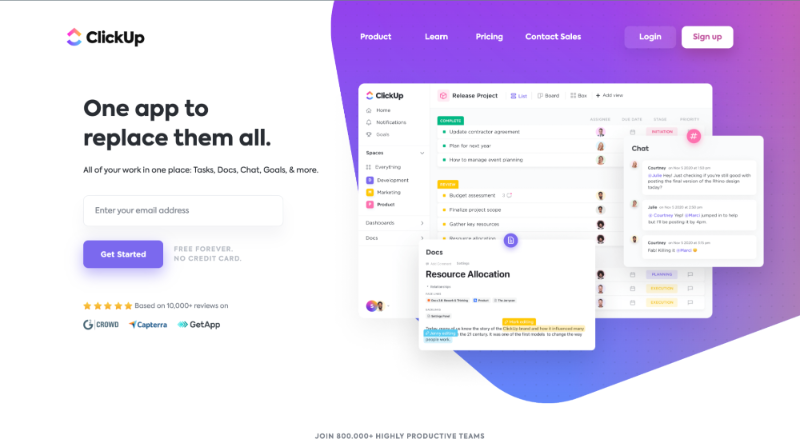
Clickup is a cloud-based project management software with a variety of features. It is most suited for graphics-intensive teams, allowing for pixel-specific comments and feedback collection. It offers document editing capabilities, inboxing, reminders, and a calendar to keep all parts of your project management process in one place.
Key features
- Workflow automation
- Supports both agile and waterfall methodologies
- Time tracking
- Document management
- Project reporting

- Offers extensive customization options
- Allows for easy tasks scheduling
- Seamless cloud-based file sharing with unregistered users
- Clean and intuitive user interface

- Slightly overwhelming list view
- There are some complaints about bugs.
Conclusion
Being a successful project manager requires a sound understanding of project management principles. Access to the right project management tools that support your project can make all the difference.
Remember to do your due diligence, assemble the right team, have a reliable review and approval workflow, and plan your project through to the end while leaving room for flexibility.

